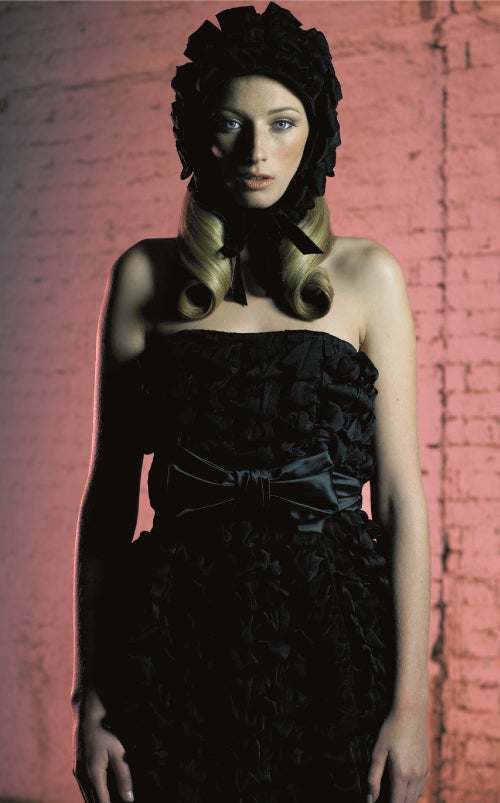Welcome to the dark side: Yves Saint Laurent's understated new collection
Stefano Pilati's new collection for Yves Saint Laurent is an unapologetic celebration of understated luxury. Susannah Frankel enjoys a taste of the black stuff

'Yves Saint Laurent's fall/winter collection is a break from the past, in many shades of black," read the notes for the show, staged in Paris last March. "As Mr Saint Laurent himself used to say: 'There is not just one black, but many blacks.'" Of course, it doesn't take the most feted designer of the 20th century to tell anyone even remotely interested in fashion that. Consumers buy black because it is flattering and easy to put together. Designers work with it because it puts all the emphasis on proportion, texture and cut, and it is extremely versatile. There are many kinds of black, indeed.
The little black dress pictured here is certainly the finest of its kind this season. It is as pretty as the proverbial picture, yet statuesque. This is very much in line with what its designer is thinking right now, and it represents something of a departure from the classically French, often unashamedly bourgeois, signature that he has given the world.
"I thought I needed to go back to the essence of the clothes," says Stefano Pilati, creative director of the Yves Saint Laurent label and responsible for both womenswear and menswear. "I thought about what the clothes mean and what it means to be a designer today." And to Pilati, being a designer meant paying more attention than ever to the pattern of a garment. "I am interested in the cut, in the volumes and in an element of opulence. I thought I was expressing real luxe with this collection but also anti-opulence, as it is perceived in the conventional way."
This dress is an idiosyncratic take on Le Smoking, the tuxedo that Yves Saint Laurent gave to haute couture womenswear in the late Sixties. He introduced women to a style that was the preserve of men's evening attire in order to relieve them of the whimsical froth that constituted their feminine alternative. Pilati is designing for a very different generation; still, any frills and flounces here are more rigorously executed, and even austere, in a very slightly twisted way.
"I wanted it to be political," says Pilati, and in this, too, he is following in the footsteps of the house's founder, who opened his first ready-to-wear boutique in 1968, the year of the French student riots, and dedicated haute couture collections - then staid, well-mannered affairs - to street styles as diverse as biker jackets and turtleneck sweaters. "We are constantly at war somewhere. Everywhere, people are dying," says Pilati. "What am I going to do - sequins and crystal everywhere? That didn't feel right. And so, I tried to be as focused as I could be on the cut of the clothes and to evoke a feeling of simplicity. I think it looks very Rive Gauche. Very Yves Saint Laurent, in its way."
Although Saint Laurent was a great colourist, he knew that black had its place centre-stage in fashion. For all the extravagance of his designs, he was a great pragmatist, putting the needs of the women who wore his clothes before his own ego - an unusual strategy in the designer-fashion arena. Pilati employs a similar approach. It should come as no great surprise, then, when he says: "My vision is only my vision if people respond to it and I respond to them and their needs. That's why I used only grey, blue and black. It's because it's the reality. I mean, who wants to wear yellow in winter?"
Although vibrant colour is not entirely off the agenda this season - everyone from Prada to Lanvin explored it - the sobriety of Pilati's collection lends it a certain dignity; instead of pandering to high-impact instant gratification this has a quieter beauty. "You might wear a colourful blouse, but you really want to wear pale green and have to wash it every time you go out. It's a little insane and, perhaps, for the sake of the press who like colour in their magazines."
In fact, in a collection that also features roomy coats, masculine suits and shoes adapted from a smart yet sensible style, this dress is frivolous by comparison. "It's just about a nice attitude, a nice feeling," Pilati says. "Maybe women will appreciate that."
If it all sounds wonderfully simple, it's worth noting that this is a highly luxurious offering, one that demonstrates a return to fine workmanship and discreet elegance - with a price tag to match. It seems all the more, well, bold for it - and, not insignificantly, more difficult to copy.
"Once you have a beautiful garment, with a beautiful cut, in a beautiful fabric, you don't need to do anything else. You don't need to make it bling. That's the direction I'm interested in moving Yves Saint Laurent in."
Given that Italian-born Pilati has become one of international fashion's main players, anyone even remotely interested in the way forward would do well to sit up and take note. Putting his money where his mouth is for the Yves Saint Laurent spring/summer 2008 season, more sober tailoring is the order of the day, some of it in nothing more obviously flashy than grey marl. True, mirrored stars add a certain lightness to the collection, for which devotees will have to wait until early next year.
Otherwise, the most beautifully proportioned trouser suits the catwalk has seen for some time, as well as more feminine, but still restrained, silk dresses that are anything but throwaway, are a continuation of a rigorously disciplined and lovely story.
Subscribe to Independent Premium to bookmark this article
Want to bookmark your favourite articles and stories to read or reference later? Start your Independent Premium subscription today.

Join our commenting forum
Join thought-provoking conversations, follow other Independent readers and see their replies